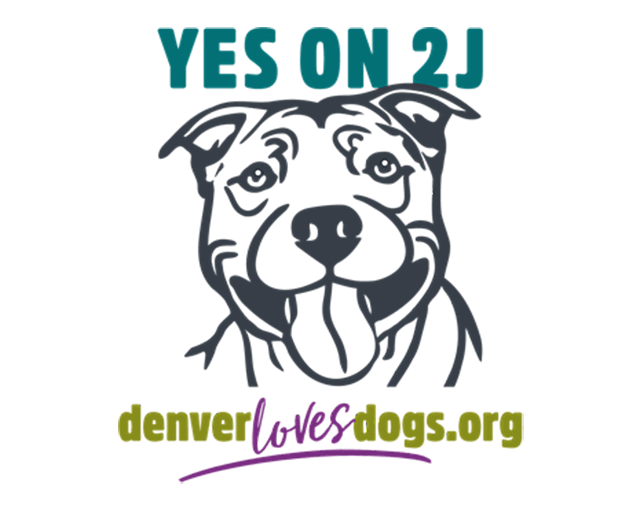
09 Oct CVMA Board of Directors votes to support ballot initiative that would roll back Denver pit bull ban
In a unanimous decision, the CVMA Board of Directors voted October 8 in support of Denver ballot measure 2J that would repeal a 30-year-old citywide ban on pit bulls.
The question on the November 3, 2020 ballot will read: Shall the voters for the City and County of Denver adopt an ordinance authorizing the city to grant a provisional permit to owners or keepers of a pit bull, provided the owner microchips the animal and complies with additional requirements set by Denver Animal Protection?
CVMA supported a similar proposal that came before the Denver City Council earlier in 2020 and testified in support of the earlier measure. That proposal was passed by the Denver City Council but then was vetoed by the mayor. This new effort puts the question in the hands of Denver voters.
The CVMA Board of Directors also voted to adopt a position statement on dangerous dog legislation (see below).
CVMA Position Statement on Dangerous Animal Legislation
Adopted by the CVMA Board of Directors October 8, 2020
The Colorado Veterinary Medical Association (CVMA) supports dangerous animal legislation that is directed at fostering safety and protection of the general public from animals classified as dangerous. CVMA does not support dangerous animal legislation that refers to specific breeds or classes of animals.
There are several reasons why breed-specific bans and restrictions are not a responsible approach to dog bite prevention:
Breed-specific laws can be difficult to enforce, especially when a dog’s breed can’t easily be determined or if it is of mixed breed. Frequently, breed-specific legislation focuses on dogs with a certain appearance or physical characteristics, instead of an actual breed. “Pit bulls” are the most frequent targets of breed-specific legislation despite being a general type rather than a breed; other breeds also are sometimes banned, including Rottweilers, Dobermans and boxers. However, it is extremely difficult to determine a dog’s breed or breed mix simply by looking at it. A study conducted by Maddie’s Fund, a national shelter initiative, showed that even people very familiar with dog breeds cannot reliably determine the primary breed of a mutt, and dogs often are incorrectly classified as “pit bulls”. Because identification of a dog’s breed with certainty is prohibitively difficult, breed-specific laws are inherently vague and very difficult to enforce.
Breed-specific legislation is discriminatory against responsible owners and their dogs. By generalizing the behaviors of dogs that look a certain way, innocent dogs and pet owners suffer. BSL can lead to the euthanasia of innocent dogs that fit a certain “look,” and to responsible pet owners being forced to move or give up dogs that have never bitten or threatened to bite. Furthermore, dogs that are considered to be of a “dangerous breed” may already be serving the community in positions such as police work, military operations, rescue purposes, and as service animals. Contrary to being a liability, these animals are assets to society; however they, too, suffer due to misinformation and breed-based stereotypes.
Breed bans do not address the social issue of irresponsible pet ownership. Dogs are more likely to become aggressive when they are unsupervised, unneutered, and not socially conditioned to live closely with people or other dogs. Banning a specific breed can give a community a false sense of security, and deemphasize to owners of other breeds the importance of appropriate socialization and training, which is a critical part of responsible pet ownership. In enacting breed-specific legislation, cities and states will spend money trying to enforce ineffective bans and restrictions rather than implementing proven solutions, such as licensing and leash laws, and responding proactively to owners of any dog that poses a risk to the community.
It is not possible to calculate a bite rate for a breed or to compare rates between breeds because the data reported is often unreliable. This is because:
- The breed of a biting dog is often not known or is reported inaccurately.
- The actual number of bites that occur in a community is not known, especially if they don’t result in serious injury.
- The number of dogs of a particular breed or combination of breeds in a community is not known because it is rare for all dogs in a community to be licensed.
- Statistics often do not consider multiple incidents caused by a single animal.
- Breed popularity changes over time, making comparison of breed-specific bite rates unreliable. However a review of the research that attempts to quantify the relation between breed and bite risk finds the connection to be weak or absent, while responsible ownership variables such as socialization, neutering and proper containment of dogs are much more strongly indicated as important risk factors.
Animal control and legislative approaches to protecting a community from dangerous dogs should not be based on breed, but instead on promoting responsible pet ownership and developing methods to rapidly identify and respond to owners whose dogs present an actual risk.
CVMA recommends the following strategies for dog bite prevention:
- Enforcement of generic, non-breed-specific dangerous dog laws, with an emphasis on chronically irresponsible owners
- Enforcement of animal control ordinances such as leash laws, by trained animal care and control officers
- Prohibition of dog fighting
- Encouraging neutering for dogs not intended for breeding
- School-based and adult education programs that teach pet selection strategies, pet care and responsibility, and bite prevention


